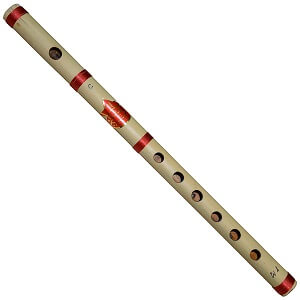Bansuri
 The bansuri is a flute made of a single hollow shaft of bamboo. It can be transverse or fipple, although the transverse variety is used in Indian classical music.
The bansuri is a flute made of a single hollow shaft of bamboo. It can be transverse or fipple, although the transverse variety is used in Indian classical music.
The word bansuri originated from Baans (bamboo) and Sur (musical note). The bansuri has six to seven holes, and, depending on the pitch varies in its size. Longer flutes enable lower pitches.
Because they are made of bamboo, each bansuri is unique and is made by taking into consideration the individual features of the bamboo.
Bansuri is a very sensitive instrument; almost all the delicate graces, curves, embellishments and shades of classical music can be performed to perfection upon it. The highest order of music can be played on this instrument, and its resonance in mandra saptak (lower octave) leaves a rare charm in the minds of its listeners. Being a portable instrument, it can be carried easily from place to place and climatic changes have very little or no effect on the seasoned bamboo.
The flute is a simple bamboo tube of uniform bore. The tube must be closed at one end. The closure may be natural, that is by the node of the stem, or, if there is no natural closure, one end may be plugged with a cork or stopper. The bamboo chosen to make the flute must be selected very carefully. It should be neither too old nor too young a plant, of medium thickness, and the stem should be clean and smooth, free from cracks, bumps, holes or other damages. Once selected the bamboo tube is best dried in the shade for approximately one year. It is then ready to be converted into a flute, to have holes of an appropriate-size and number pierced into it. The best bamboo comes from the northeast region, preferably from Assam or Tripura.
It has been extensively used in folk music. The flute can be a part of the musical orchestration for dance forms like Bharatanatyam and Kuchipudi.